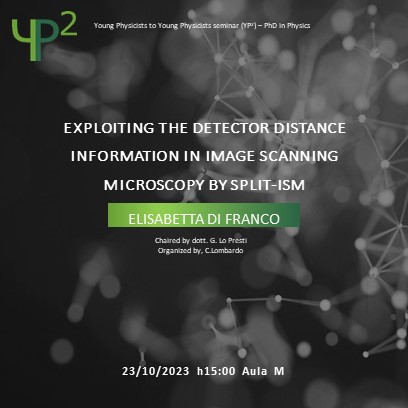Exploiting the detector distance information in image scanning microscopy by SPLIT-ISM

Lunedì 23 ottobre, con inizio alle ore 15:00, presso l'Aula M del DFA, la Dott.sa Elisabetta Di Franco terrà un seminario dal titolo Exploiting the detector distance information in image scanning microscopy by SPLIT-ISM. Il seminario appartiene al ciclo Young Physicists to Young Physicists (YP2), organizzato dai Rappresentati del Dottorato in Fisica.
Abstract: Confocal microscopy is an important bio-imaging technique which increases the resolution using a spatial pinhole to block out-of-focus light. In theory, the maximum resolution and optical sectioning is obtained when the detection pinhole is fully closed but this is prevented by the dramatic decrease of the signal reaching the detector. In image Scanning Microscopy (ISM) this limitation is overcome by using an array of point-detectors rather than a single detector. This, combined with pixel reassignment, increases the resolution of √2 over widefield imaging, with relatively little modification to the existing hardware of a laser-scanning microscope. Separation of photons by lifetime tuning (SPLIT) is a super-resolution technique, originally introduced in the context of STED microscopy, based on the phasor analysis of the fluorescent signal into an additional channel of the microscope. Our aim is to apply SPLIT technique to the images recorded by an ISM microscope to further improve the resolution, contrast, and SNR (SPLIT-ISM). Application of SPLIT requires an additional channel of the microscope. In SPLIT-ISM, we use the distance between the detectors and the center of the array. We apply the technique on data acquired by two different ISM setups: the SPAD array-ISM and the ZEISS Airyscan. We evaluate the improvement provided by SPLIT-ISM through a quantitative tool based on image correlation spectroscopy. QuICS allows extracting three parameters related to the resolution, contrast e SNR of the image.
Sunto: La microscopia confocale è un'importante tecnica di bioimaging che aumenta la risoluzione utilizzando un pinhole per bloccare la luce fuori fuoco. In teoria, la massima risoluzione e sezionamento ottico si ottiene quando il pinhole di rilevamento è completamente chiuso ma ciò è impedito dalla drastica diminuzione del segnale che raggiunge il rilevatore. Nella microscopia a scansione di immagini (ISM) questa limitazione viene superata utilizzando una serie di rilevatori puntiformi anziché un singolo rilevatore. Ciò, combinato con il pixel reassignment, aumenta la risoluzione di √2, con modifiche relativamente limitate all'hardware esistente di un microscopio a scansione laser. Separation of photons by lifetime tuning (SPLIT) è una tecnica a super risoluzione, originariamente introdotta nel contesto della microscopia STED, basata sull'analisi dei fasori del segnale fluorescente in un canale aggiuntivo del microscopio. Il nostro obiettivo è applicare la tecnica SPLIT alle immagini registrate da un microscopio ISM per migliorare ulteriormente la risoluzione, il contrasto e l'SNR (SPLIT-ISM). L'applicazione di SPLIT richiede un canale aggiuntivo del microscopio. In SPLIT-ISM, utilizziamo la distanza tra i rilevatori e il centro dell'array. Applichiamo la tecnica sui dati acquisiti da due diverse configurazioni ISM: lo SPAD array-ISM e lo ZEISS Airyscan. Valutiamo il miglioramento fornito dalla SPLIT-ISM attraverso uno strumento quantitativo basato sulla spettroscopia di correlazione delle immagini. QuICS consente di estrarre tre parametri relativi alla risoluzione, al contrasto e all'SNR dell'immagine.